This is the last known archeological investigation taken from the xaafun / hafuun site. Some very interesting findings have shown that people have inhabited the region well into antiquity. Hafuun, positioned at the eastern most tip of africa had strong commercial ties with the persian, arab and indian trade. With a natural habour perfect for protecting ships, it served as the main port for ships coming from southern africa wanting to do trade with the rest of the world.
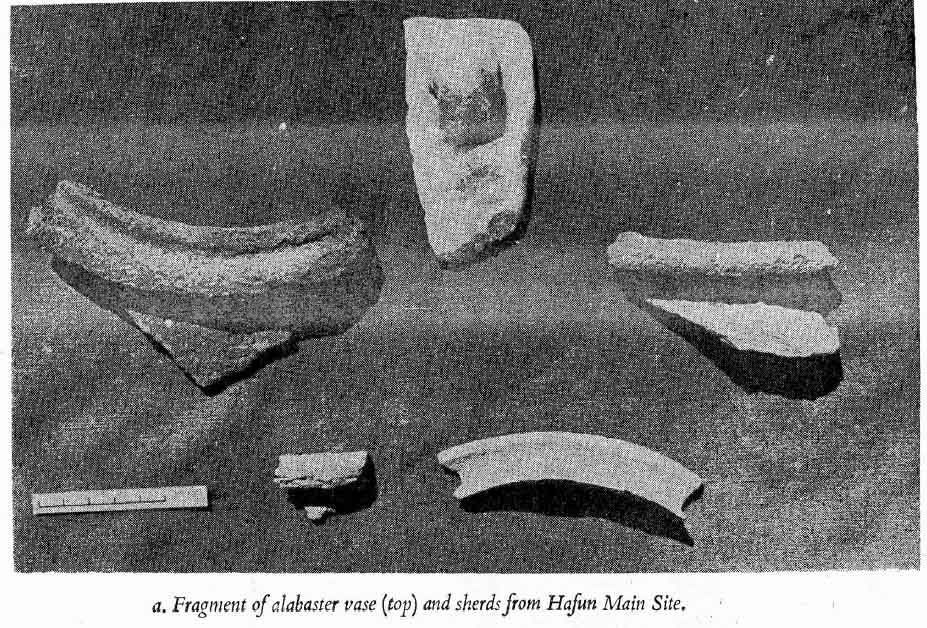
Hafun (Xaafuun in the ofiicia] orthography)
The peninsula of I-lafun lies some 150 km south of Cape
Guardafui. It consists of a massif of sandstone connected to
the mainland by a remarkable sandspit or rombelo sorne 25
km long. The excavations were carried out at two newly-
discovered sites, The first (Hafun West) is situated near the
shore of a shallow lagoon which lies between the peninsula
and the mainland. Here excavations revealed the severely
eroded and damaged remains of a structure partly built of
cut blocks. This is probably contemporary with fragments of
high-quality pottery apparently of Hellenistic origin; storage
pots of coarse soft ware were also found in the same, lower,
level. The site is presumably the remains of a small port
establishment of the second or third century BC of which the
geographers were ignorant. It would have served ships which
came through the lagoon. A wadi which derives from the
Darror Valley debouches into the western part of the lagoon;
that valley. leads to a region where it is said good quality
myrrh may be obtained. Later occupation at the site is
attributed provisionally to around the third century AD,
by which time the stone structure was in ruins. Much cooking
was carried out, apparently using the surviving part of the
southwestern wall for shelter from the wind. Among the ashy
debris a large number of turtle bones were found; one may
surmise that the shells were sold for export. There is also‘ a
substantial mound of shells of Murex tnirgfnius nearby;
these may have been used for the extraction of dye. (There
does not appear to be any documentary evidence one way
or the other on the question of whether M. vfrgfnius can
yield a dye (or that it is edible). However, dye can be obtained
from a large number of species of Muricaceae. For this
information I am indebted to Ms. K.M. Way of the British
Museum (Natural History). The edges of the lagoon are
exceptionally favourable to the production of salt by evapo-
ration, and it may be that this was carried out in antiquity.
In the vicinity are a number of small cairns built largely,
if not entirely, with stone taken from the main building, as
evidenced by cut blocks of various shapes. One of these was
excavated, revealing a crouched burial with the hands to
the face, facing west with the head to the north. There were
no grave goods, but sherds of pottery lying adjacent to other
cairns were similar to those of the later occupation of the
main building. Burials of this type accord with the description
of those of nomadic troglodytes in Strabo’s Geography
(16.4.17).
On the southern side of the Peninsula (which protects the
bay from the northeastern monsoon) lies what has been
termed Hafun Main Site. This is probably to be identified
with the mart named Opone in the Periplus (Sec. I3).
A number of test-pits were dug at this site. There is up to
2 rn of occupation, consisting mainly of bands of charcoal
and sand, together with many ovens made of old pots. There
is no sign of any permanent dwellings, though there were
some traces of substantial post—holes.
In the vicinity of the settlement site are a number of very
low eroded rectangular structures about 10 rn square; these
proved to be tombs. Excavation of two revealed a long
narrow grave, north-to-south, each with a glazed jar at the
northern end, one of these containing a glass bowl. Most
remarkably, no bones survived. It has proved diflicult to
assign a precise date to the finds from this site, but it seems
most probable that they date from the second to third
centuries AD. There are a number of cairns in the hinterland
of the settlement, some of unusual types.
South of Hafun no sites of comparable settlements have
been found.
In considering these ports which were trading with the
Mediterranean world, we are struck by the almost complete
lack of permanent structures other than tombs. Given the
very large amount of pottery (in a variety of wares) used at
Hafun, however, it would seem in view of the unsuitability
of pottery to the nomadic life that this site would have been
occupied by some of its population through the year. There
is, however, no evidence of such permanent occupation at
the Heis site, where pottery is rare.
It is remarkable that in this region no relics were found
of Islamic towns, other than settlements of the last two
centuries. It has not, however, been possible to visit Berbera,
where there are likely to be remains of early settlement.
Zeila must have been an important place in Islamic times;
no one, however, has yet identified an early site there.
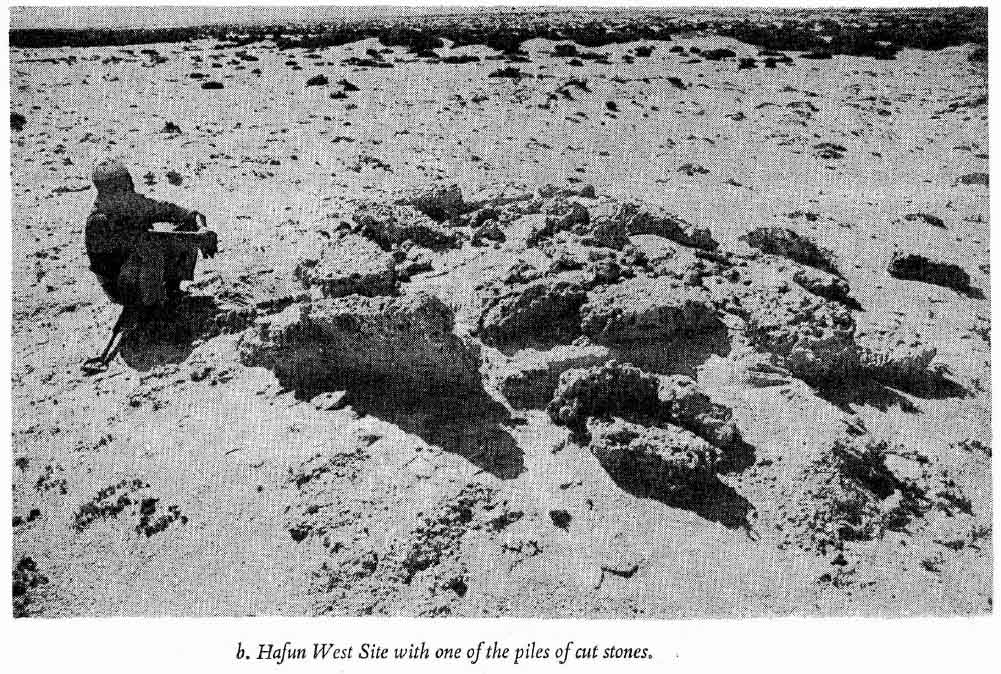
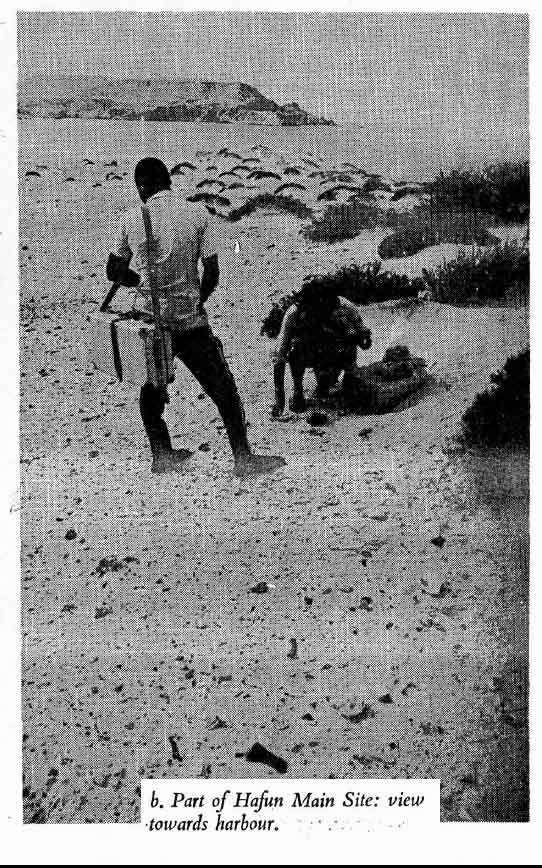
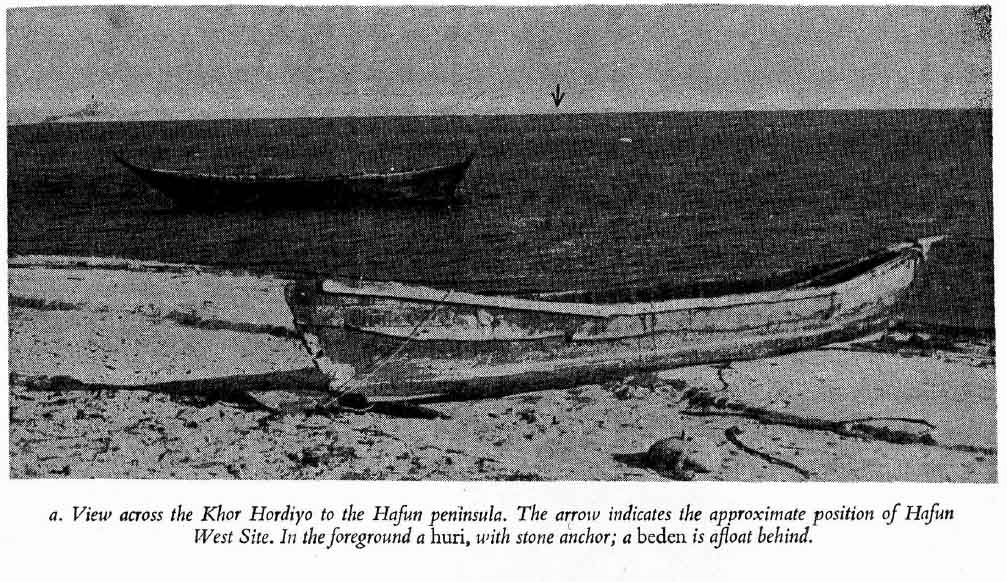
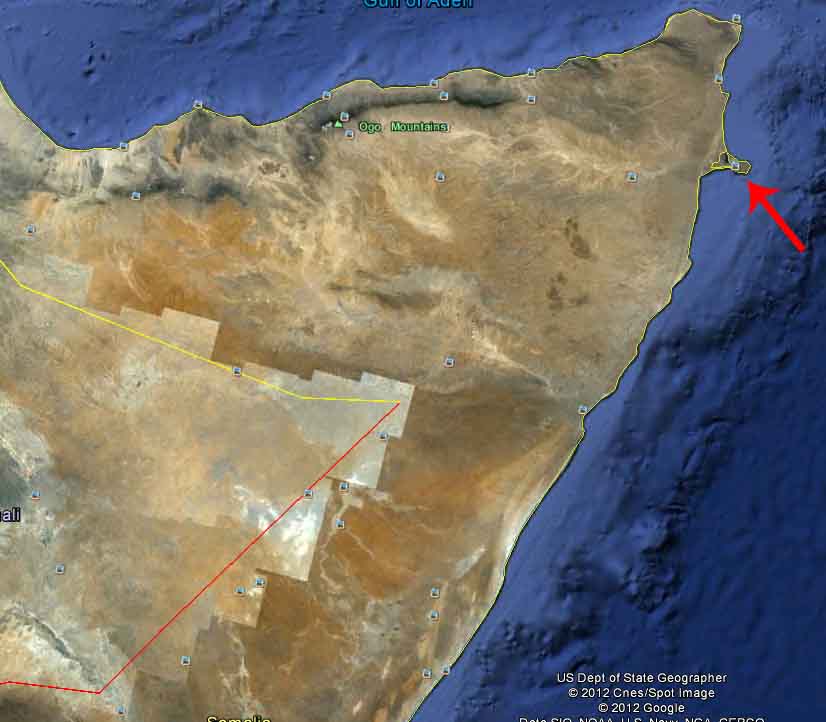

Hafun (Xaafuun in the ofiicia] orthography)
The peninsula of I-lafun lies some 150 km south of Cape
Guardafui. It consists of a massif of sandstone connected to
the mainland by a remarkable sandspit or rombelo sorne 25
km long. The excavations were carried out at two newly-
discovered sites, The first (Hafun West) is situated near the
shore of a shallow lagoon which lies between the peninsula
and the mainland. Here excavations revealed the severely
eroded and damaged remains of a structure partly built of
cut blocks. This is probably contemporary with fragments of
high-quality pottery apparently of Hellenistic origin; storage
pots of coarse soft ware were also found in the same, lower,
level. The site is presumably the remains of a small port
establishment of the second or third century BC of which the
geographers were ignorant. It would have served ships which
came through the lagoon. A wadi which derives from the
Darror Valley debouches into the western part of the lagoon;
that valley. leads to a region where it is said good quality
myrrh may be obtained. Later occupation at the site is
attributed provisionally to around the third century AD,
by which time the stone structure was in ruins. Much cooking
was carried out, apparently using the surviving part of the
southwestern wall for shelter from the wind. Among the ashy
debris a large number of turtle bones were found; one may
surmise that the shells were sold for export. There is also‘ a
substantial mound of shells of Murex tnirgfnius nearby;
these may have been used for the extraction of dye. (There
does not appear to be any documentary evidence one way
or the other on the question of whether M. vfrgfnius can
yield a dye (or that it is edible). However, dye can be obtained
from a large number of species of Muricaceae. For this
information I am indebted to Ms. K.M. Way of the British
Museum (Natural History). The edges of the lagoon are
exceptionally favourable to the production of salt by evapo-
ration, and it may be that this was carried out in antiquity.
In the vicinity are a number of small cairns built largely,
if not entirely, with stone taken from the main building, as
evidenced by cut blocks of various shapes. One of these was
excavated, revealing a crouched burial with the hands to
the face, facing west with the head to the north. There were
no grave goods, but sherds of pottery lying adjacent to other
cairns were similar to those of the later occupation of the
main building. Burials of this type accord with the description
of those of nomadic troglodytes in Strabo’s Geography
(16.4.17).
On the southern side of the Peninsula (which protects the
bay from the northeastern monsoon) lies what has been
termed Hafun Main Site. This is probably to be identified
with the mart named Opone in the Periplus (Sec. I3).
A number of test-pits were dug at this site. There is up to
2 rn of occupation, consisting mainly of bands of charcoal
and sand, together with many ovens made of old pots. There
is no sign of any permanent dwellings, though there were
some traces of substantial post—holes.
In the vicinity of the settlement site are a number of very
low eroded rectangular structures about 10 rn square; these
proved to be tombs. Excavation of two revealed a long
narrow grave, north-to-south, each with a glazed jar at the
northern end, one of these containing a glass bowl. Most
remarkably, no bones survived. It has proved diflicult to
assign a precise date to the finds from this site, but it seems
most probable that they date from the second to third
centuries AD. There are a number of cairns in the hinterland
of the settlement, some of unusual types.
South of Hafun no sites of comparable settlements have
been found.
In considering these ports which were trading with the
Mediterranean world, we are struck by the almost complete
lack of permanent structures other than tombs. Given the
very large amount of pottery (in a variety of wares) used at
Hafun, however, it would seem in view of the unsuitability
of pottery to the nomadic life that this site would have been
occupied by some of its population through the year. There
is, however, no evidence of such permanent occupation at
the Heis site, where pottery is rare.
It is remarkable that in this region no relics were found
of Islamic towns, other than settlements of the last two
centuries. It has not, however, been possible to visit Berbera,
where there are likely to be remains of early settlement.
Zeila must have been an important place in Islamic times;
no one, however, has yet identified an early site there.




